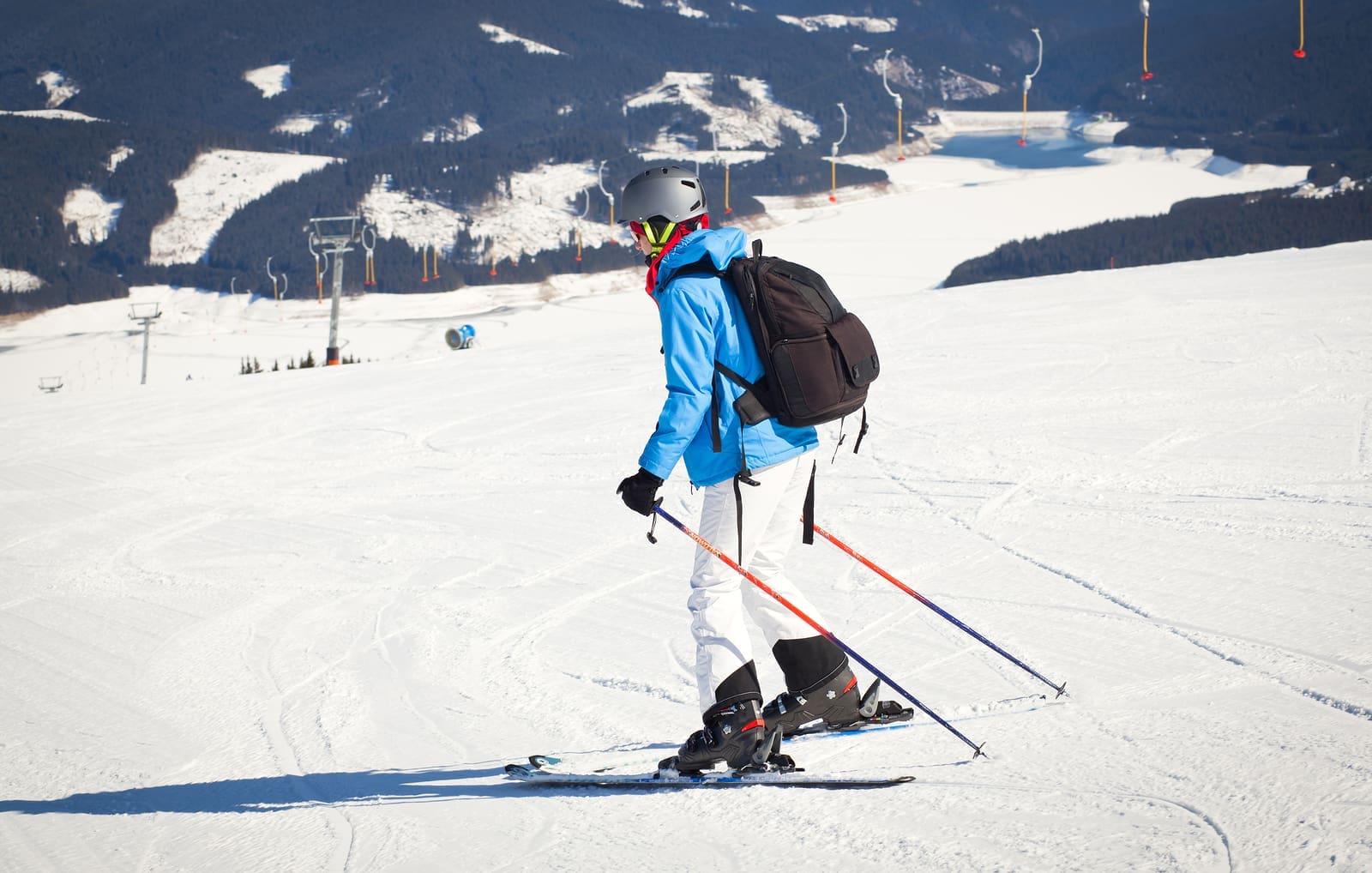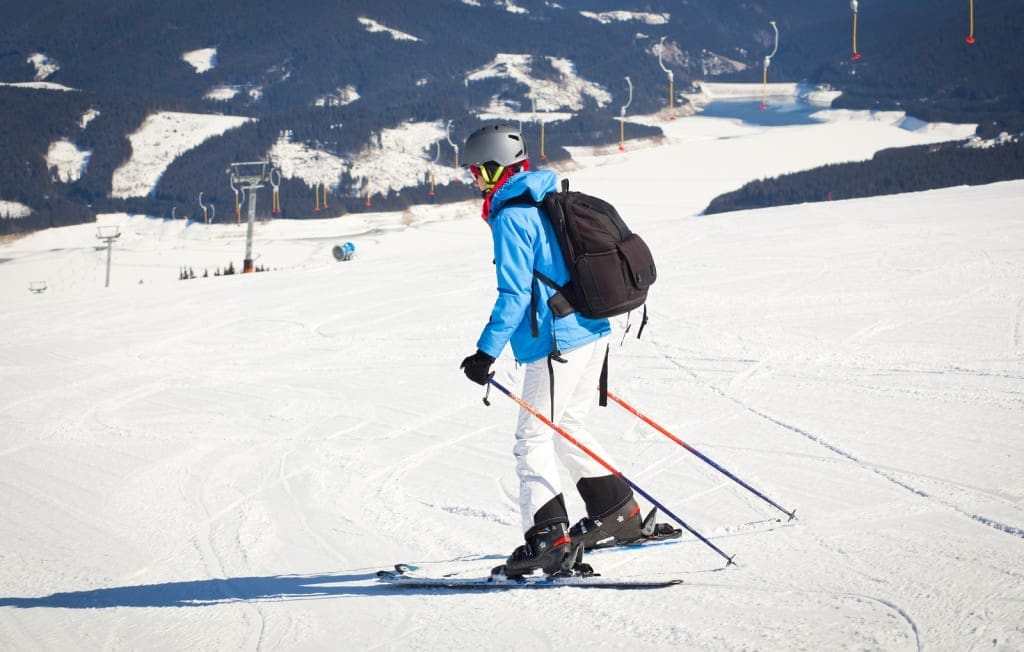
Learning to Ski at 50: Why it’s never too late
Message boards are full of people asking the same question; can I learn to ski at 50? And the majority consensus seems to be a big, loud YES!
While we all know that learning new tricks gets more challenging as we age, there are plenty of people taking to the slopes in their later years. The key to mastering the mountain is to start slow, take care and have fun.
So, if you’re in your fifties and considering taking up skiing, congratulations! The powdery pistes and jaw-dropping views of the Alps can make anyone feel like a kid again. Our guide is here to help you take the plunge safely and make the most out of your next adventure.

Can you learn to ski at 50?
As long as you are fairly fit and active, you can definitely learn to ski in your fifties. Many people take up skiing later in life and find it incredibly rewarding. In fact, according to one tour operator, two thirds of people who ski in the Alps are aged between 43 and 65.
Learning to ski at this age offers a thrilling new experience and a fantastic way to enjoy the outdoors, stay active and travel to some of the world’s most beautiful winter destinations.
How late is too late to learn how to ski?
It’s never really too late to learn how to ski! Skiing is one of those rare sports that can be enjoyed at nearly any age, from three to seventy-three and beyond. As long as you’re in reasonably good health, have the desire to learn and can move around comfortably, you can start skiing.
Is it hard to learn to ski as an adult?
Learning to ski as an adult may take a bit of practice and patience, but the reward of gliding down a snowy slope and enjoying the mountain views makes it all worthwhile.
You may also like: Learning to ski at 40
Is skiing safe for older adults?
Many people continue to ski safely well into their 60s, 70s and beyond, enjoying the physical and mental benefits that come from staying active outdoors.
Your physical condition and mobility are far more important than your age. Skiing does require balance, leg strength and some flexibility, but if you’re generally active and fit, you’re already halfway there. For those with knee, hip or back issues, it’s a good idea to talk with a healthcare provider and start with shorter, gentler runs.
How long does it take to learn skiing after 50?
Learning to ski after 50 varies from person to person, but with a few lessons, most people feel comfortable on beginner slopes within a few days. By the end of a week, you should be able to navigate these slopes at your own pace, with better control and balance.
Tips for Skiing at 50 and Beyond
From finding the right destination and pre-ski trip planning to advice for when you hit the slopes – find our tips for mastering the mountain at any age…
Gear up right
Nothing will keep you from enjoying a good day on the slopes like being cold, wet or uncomfortable in the wrong gear. Here’s what you need to get started:
- Ski Boots: Try several pairs at a ski shop to find the right fit. If you’re renting ski equipment, spend extra time in the fitting process and don’t be afraid to ask for adjustments if anything feels off.
- Skis: Start with beginner or intermediate skis, which are shorter and easier to control. Many rental places in the Alps offer a “test and swap” service if you’re uncertain.
- Layers: Start with a moisture-wicking base layer, add an insulating layer and finish with a waterproof, windproof jacket and trousers.
- A good quality helmet is non-negotiable!
Pick the right resort
In many parts of the Alps, including beginner-friendly resorts like Morzine, La Plagne or Les Gets, you’ll find smooth, easygoing blue and green slopes that let you build confidence without feeling like you’ve been in a fight the next day!
When picking a resort to start your skiing journey, look for one that has plenty of blue and green category slopes, easily accessible nursery areas and a large beginners area.
Some of the best ski resorts for beginners include;
- La Clusaz
- Le Grand Bornand
- Saint Martin de Belleville
- Saas Fee
- Meribel
You may also like: Best beginner ski resorts in Austria
Start with a professional ski school
Invest in a few hours of ski lessons at the start. Even if you’re athletic and coordinated, skiing has its own unique learning curve. Decide if you’d fare better in a group class or through private lesions with a ski instructor. A word of warning – group beginner lessons are likely to include lots of children or young people so private lessons might be more comfortable as you’re getting started.
Many instructors in Alpine ski resorts are experienced in teaching older beginners so you won’t feel out of place.
Don’t go off-piste
The mountains are vast and inviting, but remember, you’re a beginner. It’s not worth taking any unnecessary risks so stay on the groomed pistes.
If your friends are seasoned pros, it’s okay to tell them you’ll meet them for lunch. Stick with people at or close to your level, or even better, team up with other beginners from your class.
Be honest and humble
You may be a high flyer in the boardroom but you’re a newbie on the slopes. It’s super important to be honest about your ability and skiing experience so that your instructor knows what to teach you and where it’s safe for you to ski.
Find fun in the falls
Everyone learns to fall before they learn to ski. If you’re willing to laugh at yourself and have a bit of fun with it, you’ll bounce back up more easily.
Here are some strategies for making progress, even if it’s slow:
- Focus on Fundamentals: Learn to “snowplough” first. This “pizza” shape with your skis is your friend, helping you slow down and control direction. Master it before attempting parallel turns.
- Take Plenty of Breaks: Your knees, thighs and back will likely feel the burn more than you’d expect. Warm up with some gentle stretching and plan for regular breaks.
- Embrace the Process: Each day on the slopes builds skills and confidence. Even if you don’t make a perfect run, celebrate small wins like better balance or smoother turns.
- Be Careful on the Lift: Chair Lifts can be one of the trickiest parts of skiing. Don’t hesitate to tell the lift operator you’re new – they can slow down the lift for you. And if you do fall getting off, don’t worry, they’ve seen it before!
Build your strength
Skiing is a full-body workout, so be ready to feel muscles you didn’t know existed. But before hitting the slopes, consider adding strength training to your routine. Here’s how:
- Strengthen Your Core: Core stability is essential for skiing. Exercises like planks, twists and balancing drills can give you more control over your movements on the slopes.
- Leg Power: Lunges and squats will help get your legs ready for the demands of skiing.
- Practise Good Posture: Keep your weight slightly forward and knees slightly bent. Leaning back can actually make you go faster, and not in a good way!
Make the most of the Alps
The Alps are the perfect place to start skiing. Be sure to take some time off the slopes to enjoy the incredible scenery, cosy mountain huts and Swiss, French or Italian cuisine.
Even if you don’t master parallel turns on day one, soaking up the view of Mont Blanc or the Matterhorn with a hot drink in hand is an Alpine experience all its own.
At the end of the day, the Alpine après-ski scene is half the fun. Relax with some mulled wine, enjoy a cheese fondue or raclette by a roaring fire, and share your tales from the slopes (even if they involve a few wipeouts). Resorts like St. Anton in Austria or Chamonix in France are famous for their après-ski culture, but almost every ski town has charming cafés and bars where you can unwind.

Over 50 ski holidays to remember
Learning to ski at 50 is a bold move, and it’s worth every bit of the challenge. Not only are you learning a new sport, but you’re also opening up an incredible world of winter adventure that’s as exhilarating as it is beautiful.
To get from plane to piste as smoothly as possible, choose a comfortable private ski transfer for you and your travelling companions.







